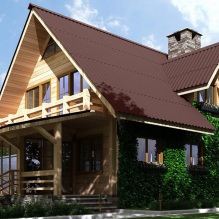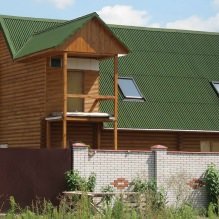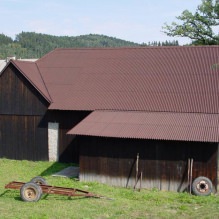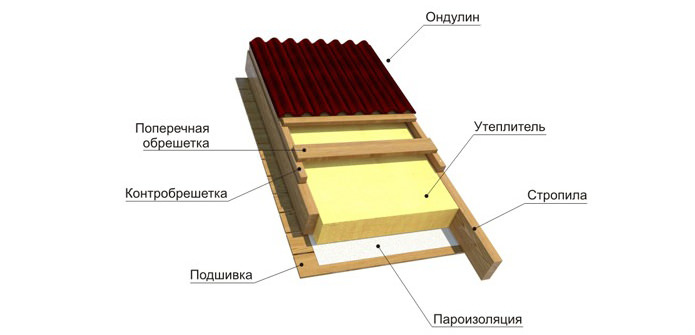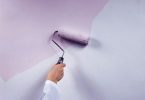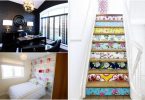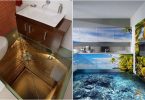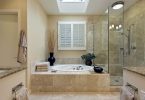Roofing ondulin is a completely natural material that is made from cellulose – the fibers that make up wood. In order to make a roof covering from them, the fibers are exposed to high temperatures and pressures, while setting a wave-like shape – corrugating.
The process takes place at a temperature of about 120 degrees. After that, the resulting sheets are impregnated with special polymer composite compounds and painted. Thanks to this, the ondulin roof is environmentally friendly, safe for humans and the environment..
This is the most waterproof roofing material, surpassing many others, even more popular, in this indicator. Another plus – over time, such a roof not only will not start to leak, but on the contrary – it will be even better to protect your home from moisture. The secret is that under the sun the roof gets very hot, and such heating gradually strengthens the structure of the material, as if “gluing” cellulose fibers with each other, which increases strength and water resistance at the same time.
Technical characteristics of ondulin
- Dimensions
Length: Width: Height = 200cm: 96cm: 0.3cm, which is the standard. Wherein “waves” corrugations are 3.6 mm high, and the area of a standard sheet is 1.92 sq. m. An important characteristic for roofing material is weight, one ondulin sheet weighs 6.5 kg.
- Fire resistance
Roofing ondulin has a low fire safety class, it ignites at temperatures from 230 degrees. Because of this, it should not be used where there is a high fire hazard or special requirements are imposed on it..
- Strength
Ondulin endures significant loads – up to 960 kg per square meter. Thus, when constructing a roof made of ondulin, one can expect a faster destruction of rafters or lathing than the roofing material itself. The material is highly resistant to aggressive environmental influences and chemical reagents: neither alkali, nor acid, nor petroleum products affect it.
- Safety
The technical characteristics of ondulin from the point of view of safety deserve the highest rating. It does not emit harmful substances, it is difficult to destroy and get injured.
- Water resistance
In practice, it is the most water-resistant material that not only does not lose these properties over time, but also vice versa – enhances them throughout the entire service life.
- Finishing types
Usually ondulin is dyed brown, green, red and black..
The whole set of characteristics allows manufacturers of the material to give a fifteen-year warranty on it. Like every material, roofing ondulin has its pros and cons. It makes sense to consider them in more detail..
pros
- Water. Water is the main “enemy” roofs, but it is not scary to the sheets of ondulin: they are impregnated with a composition that repels water, so moisture cannot penetrate into the material itself and destroy it. The coating is overlapped, hiding the attachment points and providing additional protection in the attachment points, although the corrugated sheet needs little of this: nails are driven into “top” waves, and water does not linger near the hole, not having time to penetrate inside.
- Ecology. The ondulin roof is safe for humans, as it is made of natural materials.
- External influences. Acid rain, exhaust fumes, industrial emissions have no effect on this material.
- Weight. The lighter the material, the easier it is to work with it, the less requirements for the supporting structures of the roof. Ondulin is four times lighter than slate.
- Job. The material is easily cut with a wood hacksaw, can bend and take the desired shape – all this allows it to be used on complex roofs. It is easy to unfold and mount.
- Noisiness. One of the significant advantages is the ability to save money on noise insulation. Heavy rain or birds walking on the roof will not disturb your sleep, ondulin will muffle these sounds.
Minuses
- Strength. The lack of strength of the roof should be attributed not to the technical characteristics of ondulin, but to the violations made during the installation of the rafters or the roof itself. It is necessary to observe the step of the lathing (no more than 60 cm with slopes above 15 degrees) and the number of attachment points: at least 20 nails per sheet. It is also necessary to follow the operating rules, so, in extreme heat, you should not walk on the roof.
- Fire. Insufficient fire resistance is one of the most significant disadvantages of the coating.
- Life time. How many years a roof made of ondulin will last depends on the conditions in which it is used. Too severe frosts and heat, temperature changes can shorten the life of the roof. In the middle zone, it can perform its functions for up to twenty years..
- Burnout. The attractive bright color fades over time. Loss of color too quickly means that not the original material was used, but a fake. But the branded coating is gradually losing its paint.
- Decomposition. Wood is a natural material that serves as a good substrate for mushrooms, mosses and other plants. After a couple of years, spots of moss and mold may appear on the roofing ondulin, especially in places not illuminated by the sun, and the ondulin will begin to decompose.
With careful observance of all the rules of operation, roofs made of ondulin can last for a long time, but much less than roofs made of metal or even slate will last. However, in some cases, its disadvantages are more than covered by the main advantage: low cost.
Installation of ondulin
